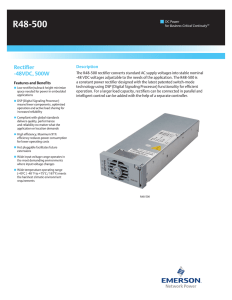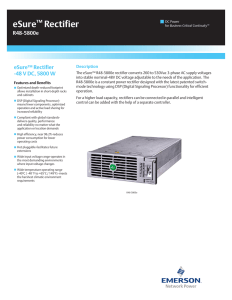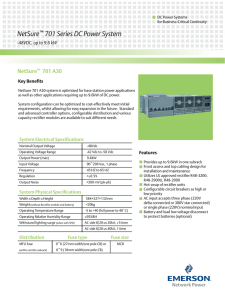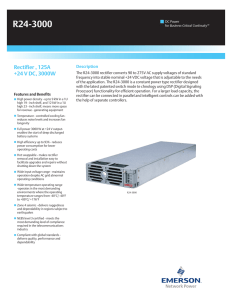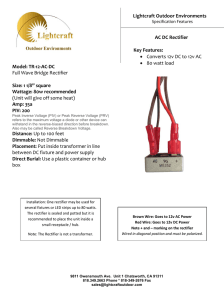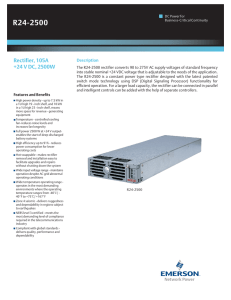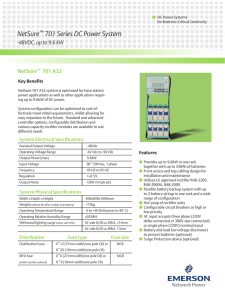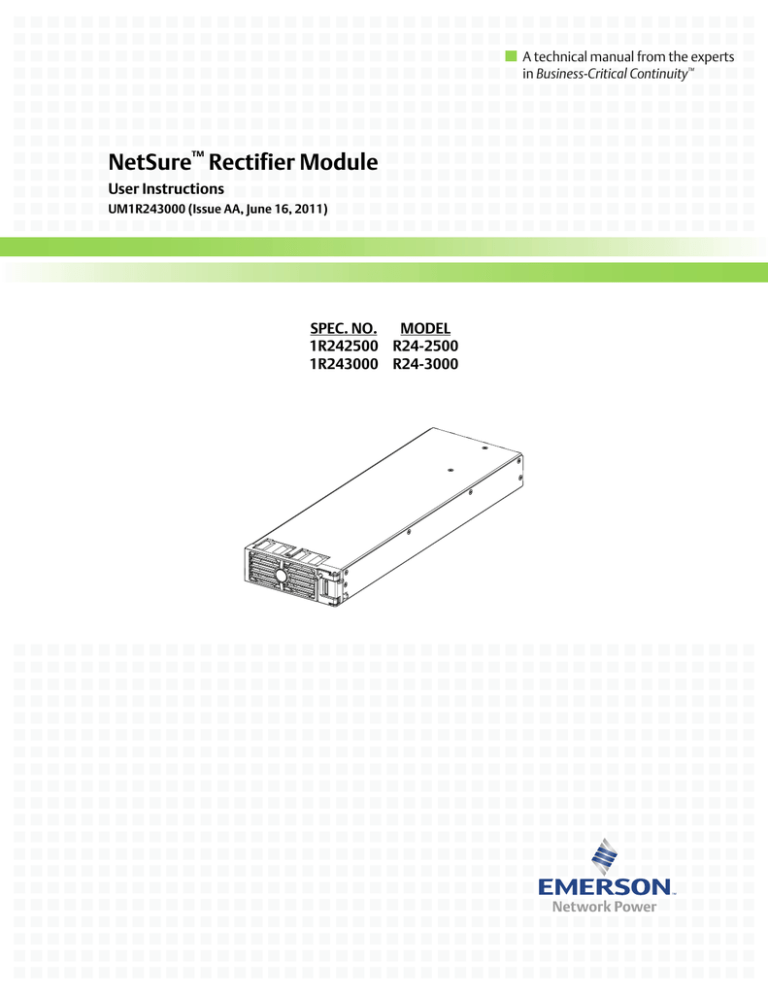
A technical manual from the experts
in Business-Critical Continuity™
NetSure™ Rectifier Module
User Instructions
UM1R243000 (Issue AA, June 16, 2011)
SPEC. NO.
MODEL
1R242500 R24-2500
1R243000 R24-3000
Business-Critical Continuity™, Emerson Network Power, and the Emerson Network
Power logo are trademarks and service marks of Emerson Electric Co.
NetSure™, NetSpan™, NetReach™, NetXtend™, and NetPerform™
are trademarks of Emerson Network Power, Energy Systems, North America, Inc.
All other trademarks are the property of their respective owners.
The products covered by this instruction manual are manufactured and/or
sold by Emerson Network Power, Energy Systems, North America, Inc.
The information contained in this document is subject to change without notice and may not be
suitable for all applications. While every precaution has been taken to ensure the accuracy and
completeness of this document, Emerson Network Power, Energy Systems, North America, Inc.
assumes no responsibility and disclaims all liability for damages resulting from use of this information
or for any errors or omissions. Refer to other local practices or building codes as applicable for the correct
methods, tools, and materials to be used in performing procedures not specifically described in this document.
This document is the property of Emerson Network Power, Energy Systems, North America, Inc.
and contains confidential and proprietary information owned by Emerson Network Power, Energy
Systems, North America, Inc. Any copying, use or disclosure of it without the written permission
of Emerson Network Power, Energy Systems, North America, Inc. is strictly prohibited.
Copyright
©
2011, Emerson Network Power, Energy Systems, North America, Inc.
All rights reserved throughout the world.
User Instructions
Spec No. 1R243000 (Model R24-3000)
Spec No. 1R242500 (Model R24-2500)
UM1R243000
Issue AA, June 16, 2011
TABLE OF CONTENTS
Introduction .......................................................................................................................... 1
Overview ....................................................................................................................... 1
Specifications ................................................................................................................ 2
Operation ........................................................................................................................... 16
Local Indicators ........................................................................................................... 16
Rectifier Module High Voltage Shutdown and Lockout Restart .................................. 17
Installing Rectifier Modules ......................................................................................... 17
Troubleshooting and Repair .............................................................................................. 18
Troubleshooting .......................................................................................................... 18
Replacement Procedures ........................................................................................... 20
Revision Record ................................................................................................................ 24
INTRODUCTION
Overview
The Rectifier Modules provide load power, battery float current, and battery recharge
current during normal operating conditions. The Rectifier Modules are a constant power
design. This means that, within the normal operating ambient temperature range, the
maximum output power available is a constant 2500W (R24-2500) or 3000W (R24-3000).
Within this ambient temperature range, the Rectifier Modules operate in one of three
modes, depending upon load demands. Transition between modes is completely
automatic.
Constant Voltage Mode: For any initial output voltage setting from 23.5 to 28.5
volts, output voltage remains constant regardless of load. This is the normal
operating condition, in which loads are supplied and batteries are float charged.
Rectifier Modules operate in the Constant Voltage Mode unless load increases to the
point where the product of load current and output voltage is approximately 2500W
(R24-2500) or 3000W (R24-3000).
Constant Power Mode: As load increases above approximately 2500W (R24-2500)
or 3000W (R24-3000) (non-adjustable), output current continues to increase, but
output voltage decreases as required to maintain constant output power. Rectifier
Modules operate in the Constant Power Mode unless load continues to increase to
the point where the current limit setting is reached.
Constant Current Mode: If load increases above the current limit setting, output
voltage decreases linearly to maintain output current at current limit.
Page 1
This document is property of Emerson Network Power, Energy Systems, North America, Inc. and contains confidential and proprietary information owned by Emerson Network Power, Energy
Systems, North America, Inc. Any copying, use, or disclosure of it without the written permission of Emerson Network Power, Energy Systems, North America, Inc. is strictly prohibited.
User Instructions
Spec No. 1R243000 (Model R24-3000)
Spec No. 1R242500 (Model R24-2500)
UM1R243000
Issue AA, June 16, 2011
Specifications
DC Output Ratings
Voltage: Nominal +24 volts DC, Negative Ground. Output voltage is adjustable from
23.50 to 28.50 volts DC via the associated Controller.
Current (One 2500W Rectifier Module): 87.7A at 28.5VDC to 104.2A at 24.0VDC.
Current (One 3000W Rectifier Module): 105.3A at 28.5VDC to 125.0A at 24.0VDC.
Power (One Rectifier Module): 2500W or 3000W at Vout ≥24VDC.
Output Characteristics: The relationship between output voltage and current is
depicted graphically in the following illustrations.
Page 2
This document is property of Emerson Network Power, Energy Systems, North America, Inc. and contains confidential and proprietary information owned by Emerson Network Power, Energy
Systems, North America, Inc. Any copying, use, or disclosure of it without the written permission of Emerson Network Power, Energy Systems, North America, Inc. is strictly prohibited.
User Instructions
Spec No. 1R243000 (Model R24-3000)
Spec No. 1R242500 (Model R24-2500)
UM1R243000
Issue AA, June 16, 2011
Power Derating Based on Input Voltage: The Rectifier Module can provide
maximum rated power (2500W or 3000W) as long as the input voltage is within the
range of 180 to 275 VAC. From 180 VAC to 90 VAC, the Rectifier Module will
continue to operate, but maximum power is reduced. The relationship between the
output power and input voltage is illustrated below.
Power Derating Based on Temperature: Each Rectifier Module continuously
monitors the ambient temperature surrounding the power conversion circuit. If this
temperature for any reason (such as a high ambient temperature or failed fan)
increases above approximately +50°C (+122°F), the Rectifier Module will not shut
down. Rather, the Rectifier Module limits its maximum output power to maintain the
temperature of the power conversion circuit within design parameters. Operation
between +50°C (+122°F) and +65°C (149°F) will result in the output power being
decreased linearly to 80% of full rated power at +65°C (149°F). Full power capability
is restored when the temperature decreases to below approximately +50°C (+122°F).
Refer to the following curve illustrating typical operating parameters.
Warning: The module is rated for continuous operation at full output power up
to +50°C (+122°F). Operation between +50°C (+122°F) and +65°C
(149°F) will result in output power decrease. Operation above +65°C
(+149°F) is considered abnormal and should be used on a
1
temporary basis only.
1
Temporary Operation at Abnormal Temperature: Temporary
operation is defined as a period of not more than eight consecutive
hours per day, and a total of not more than 15 days in a year. (This
refers to a total of 120 hours in any given year, but no more than 15
occurrences in that one-year period.)
Page 3
This document is property of Emerson Network Power, Energy Systems, North America, Inc. and contains confidential and proprietary information owned by Emerson Network Power, Energy
Systems, North America, Inc. Any copying, use, or disclosure of it without the written permission of Emerson Network Power, Energy Systems, North America, Inc. is strictly prohibited.
User Instructions
Spec No. 1R243000 (Model R24-3000)
Spec No. 1R242500 (Model R24-2500)
UM1R243000
Issue AA, June 16, 2011
Regulation:
a) Static: Steady state regulation is ±0.5% as controlled within the Rectifier Module
for any and all combinations of load from no load to full load, input voltage, and
input frequency at a constant ambient temperature. The associated system
Controller may provide improved regulation.
b) Dynamic Load: For any step load change within the range of 10% to 90% of full
load within 50 microseconds, per Telcordia GR-947-CORE, the maximum
voltage transient will not exceed ±5% of the initial steady state voltage within 250
microseconds. Recovery to within 1% of the initial steady state voltage does not
exceed 4 milliseconds.
c) Dynamic Line: Any step change of line voltage within the specified operating
range shall not cause the output voltage to deviate outside the ±0.5% regulation
band.
Filtering (with or without battery): Typical readings were taken at nominal input
voltage, nominal output voltage, 50% load, and 25°C (77°F) ambient.
a) Voice Band Noise: Complies with Telcordia GR-947-CORE.
1) Typically 30 dBrn with C-message weighting. Does not exceed 32 dBrn C.
2) Typically 0.6 millivolt psophometric. Does not exceed 1 millivolt
psophometric.
b) Wide Band Noise: Complies with Telcordia GR-947-CORE.
1) Typically 80 millivolts peak-to-peak. Does not exceed 250 millivolts peak-topeak.
2) Typically 6.3 millivolts rms. Does not exceed 50 millivolts rms.
AC Input Ratings
Voltage:
a) Normal: Nominal 208-240 volts AC, single phase, 50/60 Hz, with an operating
range of 180 to 264 volts. Acceptable input frequency range is 47 to 65 Hz.
b) Reduced Output: The Rectifier Module operates and provides reduced output
power from 180 to 90 volts.
c) Extended: The Rectifier Module operates safely to 275 volts AC.
d) Safe Voltage: The Rectifier Module tolerates 300 volts AC without damage.
Harmonic Content: Meets EN 61000-3-2.
Inrush Current: Peak does not exceed 2 times the RMS input current at full load,
nominal input voltage, and for any duration of AC input interrupts. Under the above
conditions, standard AC distribution circuit breakers will not trip.
Page 4
This document is property of Emerson Network Power, Energy Systems, North America, Inc. and contains confidential and proprietary information owned by Emerson Network Power, Energy
Systems, North America, Inc. Any copying, use, or disclosure of it without the written permission of Emerson Network Power, Energy Systems, North America, Inc. is strictly prohibited.
User Instructions
Spec No. 1R243000 (Model R24-3000)
Spec No. 1R242500 (Model R24-2500)
UM1R243000
Issue AA, June 16, 2011
Typical Input Data (1R242500): 50 Hz Input
a) System output is initially adjusted to 27.24 volts DC as measured at the system
sense point at 50% of full load and nominal input. “Percent of Full Load” refers to
percent of 87.7A at 28.5V.
Nominal
Input
Voltage
208
240
Percent
of Full
Load
Input
Current
(Amperes)
Input
VA
Input
Watts
Power
Factor
%
Heat
Efficiency
Dissipation
%
BTU/Hr
0
0.2797
58.2335
22.0705
37.9
--
75.31
25
3.373
699.7
694.102
99.2
86.18
327.34
50
6.383
1325.11
1322.46
99.8
90.42
432.24
75
9.535
1980.42
1978.44
99.9
90.85
617.36
100
12.719
2636.65
2634.01
99.9
90.57
847.69
110
13.65
2837.84
2832.16
99.8
90.38
929.30
120
13.717
2849.02
2843.32
99.8
89.69
1000.40
0
0.2962
71.1769
19.716
27.7
--
67.27
25
2.942
704.315
692.341
98.3
86.30
323.60
50
5.54
1322.95
1317.66
99.6
90.70
418.05
75
8.255
1973.77
1969.82
99.8
91.21
590.74
100
11.015
2627.08
2621.82
99.8
91.06
800.12
110
11.84
2825.02
2819.37
99.8
90.77
887.98
120
11.882
2835.05
2829.38
99.8
90.13
952.81
b) Typical Power Factor: Greater than or equal to 99.6% for any load greater than
or equal to 50% of rated full load at nominal line. Meets IEC 1000-3-2.
c) Typical Operating Efficiency: 91.21% at best point, 91.06% at full load and
nominal input voltage.
d) Maximum Input Current: 15.43A at 100% of full load with output adjusted to
28.5 volts DC as measured at the shelf output terminals, and input voltage of 180
volts.
Page 5
This document is property of Emerson Network Power, Energy Systems, North America, Inc. and contains confidential and proprietary information owned by Emerson Network Power, Energy
Systems, North America, Inc. Any copying, use, or disclosure of it without the written permission of Emerson Network Power, Energy Systems, North America, Inc. is strictly prohibited.
User Instructions
Spec No. 1R243000 (Model R24-3000)
Spec No. 1R242500 (Model R24-2500)
UM1R243000
Issue AA, June 16, 2011
Typical Input Data (1R243000): 50 Hz Input
a) System output is initially adjusted to 27.24 volts DC as measured at the system
sense point at 50% of full load and nominal input. “Percent of Full Load” refers to
percent of 105.3 A at 28.5V.
Nominal
Input
Voltage
208
240
Percent
of Full
Load
Input
Current
(Amperes)
Input
VA
Input
Watts
Power
Factor
%
Heat
Efficiency
Dissipation
%
BTU/Hr
0
0.266
55.72
15.69
28.09
--
53.35
25
3.806
792.81
786.03
99.15
91.29
232.89
50
7.359
1531.6
1528.9
99.82
93.83
320.92
75
11.055
2298.8
2296.1
99.89
93.57
502.07
100
14.832
3081.4
3076.8
99.86
93.01
730.97
110
16.164
3357.4
3351.7
99.84
92.64
838.70
120
16.25
3375.1
3369.6
99.83
92.00
915.97
0
0.296
71.28
14.63
20.56
--
49.73
25
3.314
796.91
784.15
98.4
91.40
229.29
50
6.365
1529.2
1524.6
99.7
94.11
305.19
75
9.534
2289.2
2286.3
99.88
94.01
465.89
100
12.769
3063.8
3060.5
99.9
93.52
674.80
110
13.908
3335.6
3332.3
99.9
93.17
773.43
120
13.981
3353.6
3350.4
99.9
92.59
843.96
b) Typical Power Factor: Greater than or equal to 99.7% for any load greater than
or equal to 50% of rated full load at nominal line. Meets IEC 1000-3-2.
c) Typical Operating Efficiency: 94.11% at best point, 93.52% at full load and
nominal input voltage.
d) Maximum Input Current: 18.3A at 100% of full load with output adjusted to
28.5 volts DC as measured at the shelf output terminals, and input voltage of 180
volts.
Page 6
This document is property of Emerson Network Power, Energy Systems, North America, Inc. and contains confidential and proprietary information owned by Emerson Network Power, Energy
Systems, North America, Inc. Any copying, use, or disclosure of it without the written permission of Emerson Network Power, Energy Systems, North America, Inc. is strictly prohibited.
User Instructions
Spec No. 1R243000 (Model R24-3000)
Spec No. 1R242500 (Model R24-2500)
UM1R243000
Issue AA, June 16, 2011
Typical Input Data (1R242500): 60 Hz Input
a) System output is initially adjusted to 27.24 volts DC as measured at the system
sense points at 50% of full load and nominal input. “Percent of Full Load” refers
to percent of 87.7A at 28.5V.
Nominal
Input
Voltage
208
240
Percent
of Full
Load
Input
Current
(Amperes)
Input
VA
Input
Watts
Power
Factor
%
Heat
Efficiency
Dissipation
%
BTU/Hr
0
0.3166
65.9478
21.1692
32.1
--
72.23
25
3.376
703.896
696.153
98.9
85.93
334.11
50
6.406
1330.53
1327.87
99.8
90.18
445.11
75
9.495
1973.06
1971.09
99.9
90.84
615.79
100
12.683
2639.33
2636.69
99.9
90.57
848.46
110
13.683
2839.22
2833.54
99.8
90.26
942.01
120
13.69
2846.15
2840.46
99.8
89.74
994.54
0
0.3433
82.4263
19.535
23.7
--
66.66
25
2.956
708.258
691.259
97.6
86.51
318.16
50
5.551
1327.8
1322.49
99.6
90.59
424.57
75
8.288
1975.86
1971.91
99.8
91.15
595.74
100
11.054
2625.33
2622.7
99.9
91.07
799.42
110
11.885
2819.12
2816.3
99.9
90.95
869.93
120
11.875
2827.44
2824.61
99.9
90.27
937.98
b) Typical Power Factor: Greater than or equal to 99.6% for any load greater than
or equal to 50% of rated full load at nominal line. Meets IEC 1000-3-2.
c) Typical Operating Efficiency: 91.15% at best point, 91.07% at full load and
nominal input voltage.
d) Maximum Input Current: 15.43A at 100% of full load with output adjusted to
28.5 volts DC as measured at the shelf output terminals, and input voltage of 180
volts.
Page 7
This document is property of Emerson Network Power, Energy Systems, North America, Inc. and contains confidential and proprietary information owned by Emerson Network Power, Energy
Systems, North America, Inc. Any copying, use, or disclosure of it without the written permission of Emerson Network Power, Energy Systems, North America, Inc. is strictly prohibited.
User Instructions
Spec No. 1R243000 (Model R24-3000)
Spec No. 1R242500 (Model R24-2500)
UM1R243000
Issue AA, June 16, 2011
Typical Input Data (1R243000): 60 Hz Input
a) System output is initially adjusted to 27.24 volts DC as measured at the system
sense points at 50% of full load and nominal input. “Percent of Full Load” refers
to percent of 105.3A at 28.5V.
Nominal
Input
Voltage
208
240
Percent
of Full
Load
Input
Current
(Amperes)
Input
VA
Input
Watts
Power
Factor
%
Heat
Efficiency
Dissipation
%
BTU/Hr
0
0.308
64.22
15.83
24.67
--
53.81
25
3.819
795.63
787.42
98.97
91.05
239.65
50
7.361
1532.2
1529.2
99.81
93.75
324.91
75
11.057
2299.3
2296.4
99.88
93.56
503.09
100
14.835
3082.1
3077
99.84
93.00
732.76
110
16.165
3357.7
3351.5
99.81
92.61
842.20
120
16.253
3375.7
3369.5
99.81
92.03
912.86
0
0.344
82.94
14.55
17.58
--
49.45
25
3.334
801.78
784.97
97.91
91.18
235.50
50
6.372
1531.2
1525.7
99.64
93.87
318.19
75
9.537
2289.9
2286.9
99.87
93.89
475.13
100
12.77
3064.1
3060.8
99.9
93.46
680.27
110
13.908
3336.8
3333.1
99.89
93.14
777.23
120
13.981
3354.1
3350.4
99.89
92.54
849.45
b) Typical Power Factor: Greater than or equal to 99.6% for any load greater than
or equal to 50% of rated full load at nominal line. Meets IEC 1000-3-2.
c) Typical Operating Efficiency: 93.89% at best point, 93.46% at full load and
nominal input voltage.
d) Maximum Input Current: 18.3A at 100% of full load with output adjusted to
28.5 volts DC as measured at the shelf output terminals, and input voltage of 180
volts.
Page 8
This document is property of Emerson Network Power, Energy Systems, North America, Inc. and contains confidential and proprietary information owned by Emerson Network Power, Energy
Systems, North America, Inc. Any copying, use, or disclosure of it without the written permission of Emerson Network Power, Energy Systems, North America, Inc. is strictly prohibited.
User Instructions
Spec No. 1R243000 (Model R24-3000)
Spec No. 1R242500 (Model R24-2500)
UM1R243000
Issue AA, June 16, 2011
Environmental Ratings
Operating Ambient Temperature Range: -40°C to +75°C (-40°F to +167°F).
Specification Compliant Temperature Range:
a) R24-2500: -20°C to +70°C (-4°F to +158°F).
b) R24-3000: -20°C to +65°C (-4°F to +149°F).
Reduced Load Temperature Range: +50°C to +75°C (+122 to +167°F).
Storage Ambient Temperature Range: -40°C to +85°C (-40°F to +185°F).
Humidity: This Rectifier Module is capable of operating in an ambient relative
humidity range of 0% to 95%, non-condensing.
Altitude: This Rectifier Module is capable of operating in an altitude range of -200
feet to 10,000 feet. The maximum operating ambient temperature should be de-rated
by 3°C per 1000 feet above 5000 feet.
Ventilation Requirements: The Rectifier Module is fan cooled and utilizes front to
back forced ventilation.
Single Rectifier Audible Noise: The audible noise at any point two feet from any
vertical surface of a Rectifier Mounting Shelf (with one Rectifier installed and fans
operating) does not exceed the following limits. The audible noise was measured
with the fan control circuit enabled. A Sound Level Meter conforming to ANSI S1.4
was used.
a) 50dB-A maximum at less than 32°C ambient, half load or less.
b) 60dB-A maximum at less than 32°C ambient, full load.
c) 70dB-A maximum at greater than 32°C ambient, full load.
EMI/RFI Suppression: Rectifier Modules operating in a Module Mounting Shelf
conform to the requirements of FCC rules Part 15, Subpart B, Class B for Radiated
and Conducted emissions limits.
Surge Protection: Compliance with EN61000-4-5 Installation Class 4, and capable
of withstanding surges per ANSI/IEEE C 62.41 1980 Category B3 across the input
terminals.
Note: This level of protection is a widely used standard for telecommunications
power equipment. As with all such equipment, it is the end user's
responsibility to provide an adequately sized Surge Suppression Device at the
commercial power service entrance of the building that reduces all incoming
surges to levels below the classes/categories stated for the equipment.
Page 9
This document is property of Emerson Network Power, Energy Systems, North America, Inc. and contains confidential and proprietary information owned by Emerson Network Power, Energy
Systems, North America, Inc. Any copying, use, or disclosure of it without the written permission of Emerson Network Power, Energy Systems, North America, Inc. is strictly prohibited.
User Instructions
Spec No. 1R243000 (Model R24-3000)
Spec No. 1R242500 (Model R24-2500)
UM1R243000
Issue AA, June 16, 2011
Compliance Information
Safety Compliance: This unit meets the requirements of UL 60950-1, Standard for
Information Technology Equipment, and is UL Recognized as a power supply for use
in Telephone, Electronic Data Processing or Information Processing Equipment. This
unit meets the requirements of CAN/CSA 22.2, No. 60950-00 and is tested and
Certified by UL ("c UR") as a Component Type Power Supply.
The Rectifier Module is RoHS 5/6 compliant.
NEBS Compliance (when used in a compliant system): Compliance verified by a
Nationally Recognized Testing Laboratory (NRTL) per GR-1089-CORE and GR-63CORE. Contact Emerson Network Power for NEBS compliance reports.
Standard Features
Type of Power Conversion Circuit: High frequency.
Constant Voltage Mode: For any initial output voltage setting from 23.5 to 28.5
volts, output voltage remains constant regardless of load. This is the normal
operating condition, in which loads are supplied and batteries are float charged.
Rectifier Modules operate in the Constant Voltage Mode unless load increases to the
point where the product of load current and output voltage is approximately 2500W
(R24-2500) or 3000W (R24-3000).
Constant Power Mode: As load increases above approximately 2500W (R24-2500)
or 3000W (R24-3000) (non-adjustable), output current continues to increase, but
output voltage decreases as required to maintain constant output power. Rectifier
Modules operate in the Constant Power Mode unless load continues to increase to
the point where the current limit setting is reached.
Constant Current Mode: If load increases above the current limit setting, output
voltage decreases linearly to maintain output current at current limit.
Input Protection:
a) Fusing: The Rectifier Module contains double pole/neutral fusing (non userreplaceable). Customer is to provide AC input branch circuit protection.
b) Low Input Voltage: The Rectifier Module shuts down and its protection
indicator (yellow) illuminates if input voltage decreases below 85VAC. The
Rectifier Module automatically restarts when the input voltage returns to within
the normal operating range. A low input voltage condition does not trip the
recommended input protection device.
c) High Input Voltage: The Rectifier Module shuts down and its protection
indicator (yellow) illuminates if input voltage increases above 280VAC. The
Rectifier Module automatically restarts when the input voltage returns to within
the normal operating range.
d) Power Interruption: Interruption and restoration of input power does not affect
the proper operation of the controls, alarm signals, or visual indicators. On
restoration of input power, the Rectifier Module automatically restarts without
Page 10
This document is property of Emerson Network Power, Energy Systems, North America, Inc. and contains confidential and proprietary information owned by Emerson Network Power, Energy
Systems, North America, Inc. Any copying, use, or disclosure of it without the written permission of Emerson Network Power, Energy Systems, North America, Inc. is strictly prohibited.
User Instructions
Spec No. 1R243000 (Model R24-3000)
Spec No. 1R242500 (Model R24-2500)
UM1R243000
Issue AA, June 16, 2011
manual intervention and without operating protective devices, even if connected
to a completely discharged battery string or capacitor bank.
Output Protection:
a) Current Limiting: The maximum current delivered by the Rectifier Module can
be programmed from 10% to 120% of full load rating via the Controller. If
communication to the Controller is lost, the Rectifier Module default value is
121% of full load rating. Full load rating for Rectifier Modules is defined as the
maximum current available over the entire output voltage range (88A for
R24-2500, 104A for R24-3000). The Rectifier Module can start when connected
to a completely discharged battery or capacitor bank without operating Rectifier
Module protective devices or needing any manual intervention.
b) Fusing: The Rectifier Module contains an output fuse (non user-replaceable).
Rectifier Module output power is lost and its fault indicator (red) illuminates if the
output fuse opens The Rectifier Module can be plugged into or pulled out of a
shelf while operating, without damage or opening the fuse.
c) High Voltage Shutdown:
1) Adjustable Control: If output voltage exceeds an adjustable preset value
(set via Controller) and the Rectifier Module is delivering more than 10% of
its rated current, the Rectifier Module shuts down.
After approximately 3 seconds, the Rectifier Module automatically restarts. If
output voltage again exceeds the high voltage shutdown value within 5
minutes, the Rectifier Module shuts down and locks out. Manual restart is
then required (by turning AC power to the Rectifier Module off or by removing
the Rectifier Module, waiting 30 seconds, then turning AC power to the
Rectifier Module on or re-inserting the Rectifier Module). If the Rectifier
Module does not experience a high voltage condition within the 5-minute
time-period, the restart circuit is reset.
If two or more Rectifier Modules are installed in a shelf, or if the shelf is
paralleled with other Module Mounting Shelves, only the Rectifier Module
causing the high voltage condition shuts down.
Adjustable from 24.00 to 29.75 volts DC via the Controller.
2) Backup: If Rectifier Module output voltage exceeds a second (nonadjustable) value of 31.0VDC ±0.5VDC, the Rectifier Module shuts down and
locks out regardless of load. Manual restart is then required [by turning AC
power to the Rectifier Modules off then on, or by removing and re-inserting
the Rectifier Modules].
Power Factor Correction Failure: If the power factor correction circuit fails and
results in over/low DC bus voltage, the Rectifier Module shuts down and its protection
indicator (yellow) illuminates.
Rectifier Module DC/DC Converter Failure: If the Rectifier Module’s DC/DC
converter fails, the Rectifier Module shuts down and the fault indicator (red)
illuminates.
Page 11
This document is property of Emerson Network Power, Energy Systems, North America, Inc. and contains confidential and proprietary information owned by Emerson Network Power, Energy
Systems, North America, Inc. Any copying, use, or disclosure of it without the written permission of Emerson Network Power, Energy Systems, North America, Inc. is strictly prohibited.
User Instructions
Spec No. 1R243000 (Model R24-3000)
Spec No. 1R242500 (Model R24-2500)
UM1R243000
Issue AA, June 16, 2011
Rectifier Module Load Sharing (per Bay): The Rectifier Module shares load with
other like Rectifier Modules operating in parallel on one CAN communications bus to
within ±3% of the ratings of the Rectifier Modules when between 10%~100% load
(maximum 28 Rectifier Modules).
If R24-2500 and R24-3000 Rectifier Modules are operating in the same system, they
will share load at the ratio of their output power ratings.
Startup Time: The Rectifier Module has two startup modes.
a) Normal Startup:
Start up time, defined as beginning at AC input being applied and ending
when full output power has been reached, consists of two time intervals, the
delay period and the output voltage ramp up period.
During the delay period the output voltage will be zero.
Start up time (from AC on until full power): ≤ 5 seconds.
Output voltage ramp up period, t: 50 ≤ t ≤ 150 ms. (10% to 90% of full
power) (if walk-in feature is disabled).
The rise time is retained with a DC load of 0.31 Ohm (+24.0VDC & 87.7A).
The Rectifier Module will not suffer any damage when subjected to repetitive
AC voltage on / off operations.
b) Output Voltage Walk-In: Meets Telcordia GR-947-CORE, R3-19. Output
voltage gradually increases after AC service is supplied or restored. Ramp-up
time is settable via the Controller. The Controller can enable/disable this feature.
Hot Swappable: The Rectifier Module is designed to be plug-and-play. The
Rectifier Module can be inserted or removed from a live DC power system with no
damage. When the Rectifier Module is plugged into the system, the system output
voltage will not be affected.
Cooling: Each Rectifier Module contains two fans for forced convection cooling.
a) Fan Fault Protection: The Rectifier Module shuts down and its fault indicator
(red) flashes if either fan fails. Fan failure is detected and reported to Controller.
The fans are field replaceable.
b) Fan Control: Fan speed is continuously variable. When input voltage is within
normal range, the built-in processor adjusts fan speed according to the Rectifier
Module’s internal temperature and output power. For example, a higher
temperature or output power increases the fan speed. Fan speed control can be
disabled by the Controller.
Communication Failure: The Rectifier Module’s protection indicator (yellow) will
flash should it experience a communication failure. The failure information will be
reported to the Controller and the Controller will process the failure accordingly.
During a communication failure, in order to protect the battery, the Rectifier Module
output voltage will automatically be adjusted as follows. When used with the SCU+
Page 12
This document is property of Emerson Network Power, Energy Systems, North America, Inc. and contains confidential and proprietary information owned by Emerson Network Power, Energy
Systems, North America, Inc. Any copying, use, or disclosure of it without the written permission of Emerson Network Power, Energy Systems, North America, Inc. is strictly prohibited.
User Instructions
Spec No. 1R243000 (Model R24-3000)
Spec No. 1R242500 (Model R24-2500)
UM1R243000
Issue AA, June 16, 2011
Controller, Rectifier Module output voltage goes to a default value (53.5 V, which can
be modified using the SCU+ Controller). When used with the ACU+ Controller,
Rectifier Module output voltage goes to the ACU+ float voltage setting (this setting is
stored in the Rectifier Module). The Rectifier Module will revert to normal operation
once normal communication is restored.
Output Current Imbalance:
a) When the average current of all Rectifier Modules is greater than 20% of full
rated current, and the difference between local Rectifier Module current and
average current is greater than 16% of full rated current, the yellow protection
indicator will illuminate.
b) When the average current of all Rectifier Modules is greater than 10% of full
rated current, and local Rectifier Module current is less than 1.5% of full rated
current, then the red fault indicator will illuminate.
Paralleling: This Rectifier Module may be connected in parallel with any Rectifier
Module of the same polarity and adjusted to the same output voltage.
Monitoring Function: The Rectifier Module has a built-in advanced DSP (Digital
Signal Processor) that monitors and controls the operation of the Rectifier Module.
The DSP also communicates with the associated system Controller in real time
through the CAN bus. The following table lists the different commands and
information exchanged between the Rectifier Module and the Controller.
Page 13
This document is property of Emerson Network Power, Energy Systems, North America, Inc. and contains confidential and proprietary information owned by Emerson Network Power, Energy
Systems, North America, Inc. Any copying, use, or disclosure of it without the written permission of Emerson Network Power, Energy Systems, North America, Inc. is strictly prohibited.
User Instructions
Spec No. 1R243000 (Model R24-3000)
Spec No. 1R242500 (Model R24-2500)
UM1R243000
Issue AA, June 16, 2011
Commands / signals that can be
received by the Rectifier Module
from the Controller.
Turn On/Off
Voltage Walk-in On/Off
HVSD Reset
Current Limit Adjustment
Voltage Adjustment
Fan Speed Control
Enable/Disable
Information gathered by the
Controller from the Rectifier
Module.
Input Voltage
Output Voltage
Output Current
Current Limit Setting
Temperature
Over Voltage Setting
On/Off Status
Fault Alarms, such as:
HVSD
Fan Fail
Protection Alarms, such as:
Input Voltage Protection
Inner DC Bus Voltage Protection
High Temperature Protection
Thermal Derating
AC Derating
AC Fail
Imbalanced Output Current
Address
Code
Date
Software Version
Hardware Version
External Control Circuits: Provided via the associated Controller. Refer to the
separate Power System documentation for a complete description of available
external control circuits.
External Alarm Circuits: Provided via the associated Controller. Refer to the
separate Power System documentation for a description of available external alarms.
Page 14
This document is property of Emerson Network Power, Energy Systems, North America, Inc. and contains confidential and proprietary information owned by Emerson Network Power, Energy
Systems, North America, Inc. Any copying, use, or disclosure of it without the written permission of Emerson Network Power, Energy Systems, North America, Inc. is strictly prohibited.
User Instructions
Spec No. 1R243000 (Model R24-3000)
Spec No. 1R242500 (Model R24-2500)
UM1R243000
Issue AA, June 16, 2011
Mechanical Specifications
Weight: 6.4 lbs (2.9 kg).
Dimensions (H x W x D): 1.63” (41.4mm) x 4.88” (124mm) x 14.96” (380mm).
Local Controls: None.
Local Status and Alarm Indicators:
a) Power (Green)
b) Protection (Yellow)
c) Alarm (Red)
Page 15
This document is property of Emerson Network Power, Energy Systems, North America, Inc. and contains confidential and proprietary information owned by Emerson Network Power, Energy
Systems, North America, Inc. Any copying, use, or disclosure of it without the written permission of Emerson Network Power, Energy Systems, North America, Inc. is strictly prohibited.
User Instructions
Spec No. 1R243000 (Model R24-3000)
Spec No. 1R242500 (Model R24-2500)
UM1R243000
Issue AA, June 16, 2011
OPERATION
Local Indicators
Location and Identification: Refer to Figure 1.
Description: There are three (3) indicators located on the Rectifier Module’s front panel.
The functions of these indicators are as shown in Table 1.
Note: DC voltage must be present at the Rectifier Module output terminals (from battery
or an operating Rectifier Module) or AC voltage at the input terminals for local
indicators to illuminate.
RECTIFIER MODULE
Power Indicator
(Green)
Protection Indicator
(Yellow)
Fault Indicator
(Red)
Figure 1
Local Indicator Locations
Indicator
Power
(Green)
Protection
(Yellow)
Normal State
Alarm State
Off
On
Off
Flashing
On
Flashing
Fault
(Red)
On
Off
Flashing
Alarm Cause
No input voltage.
Internal input fuse open.
The Rectifier Module is being identified
by the Controller.
AC input under/over voltage.
PFC output under/over voltage.
High temperature.
Moderate load sharing imbalance.
Loss of communication with controller.
Severe load sharing imbalance.
Rectifier Module output disabled for any
reason, including overvoltage shutdown
and internal output fuse open.
Faulty fan (Rectifier Module shuts
down).
Table 1
Rectifier Module Indicators
Page 16
This document is property of Emerson Network Power, Energy Systems, North America, Inc. and contains confidential and proprietary information owned by Emerson Network Power, Energy
Systems, North America, Inc. Any copying, use, or disclosure of it without the written permission of Emerson Network Power, Energy Systems, North America, Inc. is strictly prohibited.
User Instructions
Spec No. 1R243000 (Model R24-3000)
Spec No. 1R242500 (Model R24-2500)
UM1R243000
Issue AA, June 16, 2011
Rectifier Module High Voltage Shutdown and Lockout Restart
Turn AC power to the Rectifier Module OFF or remove the Rectifier Module, wait 30
seconds or more, then turn AC power to the Rectifier Module ON or re-insert the Rectifier
Module.
Installing Rectifier Modules
The Rectifier Module is hot swappable. It can be installed with the system operating.
Warning: To prevent damage to the latching mechanism, ensure the handle is in
the open position when installing or removing a Rectifier Module.
NEVER hold the handle in the closed position when installing a Rectifier
Module into a shelf.
Procedure
1) Place the module into an unoccupied mounting slot without sliding it in
completely.
2) Loosen the captive screw on the module handle. Pull the handle to pivot it out of
the module front panel (this will also retract the latch mechanism located at the
right side of the module). Refer to Figure 2 for latch mechanism illustration.
3) Push the Rectifier Module completely into the shelf.
4) Push the handle into the front panel of the module. This will lock the module
securely to the shelf. Tighten the captive screw on the handle.
5) Repeat the above steps for each Rectifier Module being installed in the system.
6) After the Rectifier Modules are physically installed in the mounting shelf(s), they
are ready for operation immediately after power is supplied to them.
7) Certain functions (i.e. rectifier current limit, rectifier addressing) may require
adjustment when adding or replacing a Rectifier Module. Refer to the Power
System documentation for instructions.
Page 17
This document is property of Emerson Network Power, Energy Systems, North America, Inc. and contains confidential and proprietary information owned by Emerson Network Power, Energy
Systems, North America, Inc. Any copying, use, or disclosure of it without the written permission of Emerson Network Power, Energy Systems, North America, Inc. is strictly prohibited.
User Instructions
Spec No. 1R243000 (Model R24-3000)
Spec No. 1R242500 (Model R24-2500)
UM1R243000
Issue AA, June 16, 2011
Note: Handle must be
open when installing
or removing module.
Screw
Handle in
Closed Position
Figure 2
Rectifier Module Handle/Latch Mechanism
TROUBLESHOOTING AND REPAIR
Troubleshooting
Rectifier Module Imbalanced Current Sharing
When multiple Rectifier Modules are operating in parallel and load is 10%-100%, then if
the current sharing imbalance among them is greater than +/-3A of the average rectifier
current, check if the Rectifier Module is properly seated in the shelf.
If the current sharing imbalance still persists following the verification suggested above,
replace the Rectifier Module exhibiting the current imbalance.
Rectifier Module Fault Symptoms and Troubleshooting
The fault indicators that can be displayed by the Rectifier Module are as follows. Refer to
Table 2 for a list of possible causes and corrective actions.
Power Indicator (Green) OFF
Protection Indicator (Yellow) ON
Protection Indicator (Yellow) Flashing
Alarm Indicator (Red) ON
Alarm Indicator (Red) Flashing
Page 18
This document is property of Emerson Network Power, Energy Systems, North America, Inc. and contains confidential and proprietary information owned by Emerson Network Power, Energy
Systems, North America, Inc. Any copying, use, or disclosure of it without the written permission of Emerson Network Power, Energy Systems, North America, Inc. is strictly prohibited.
User Instructions
Spec No. 1R243000 (Model R24-3000)
Spec No. 1R242500 (Model R24-2500)
Symptom
Power
Indicator
(Green) Off
UM1R243000
Issue AA, June 16, 2011
Possible Cause(s)
Suggested Action(s)
No input voltage.
Make sure there is input voltage.
Internal input fuse open.
Replace the Rectifier Module.
AC input voltage outside the
normal range.
Correct the AC input voltage to
within the acceptable range.
PFC over-voltage.
Replace the Rectifier Module.
Moderate load sharing imbalance.
Replace the Rectifier Module.
Rectifier Module over-temperature protection, which could be caused
by:
Protection
Indicator
(Yellow) On
1. Fan rotor blocked.
1. Remove any object that may
be blocking the fan.
2. Ventilation blocked (inlet or
outlet).
2. Remove any object that may
be blocking the inlet or outlet.
3. Ambient temperature too high
or Rectifier Module inlet too close
to a heat source.
3. Lower the ambient temperature
or relocate the heat source.
Rectifier Module not inserted into
the slot completely.
Remove and properly insert the
Rectifier Module.
Rectifier Module communication
failure.
Check the communication cables.
Remove and properly insert the
Rectifier Module.
Alarm
Indicator
(Red) On
Output over-voltage shutdown.
Severe load sharing imbalance.
Internal output fuse open.
Remove the Rectifier Module
from its shelf and then reinstall
after 30 seconds. If Rectifier
Module fails to start, shuts down
again, or load sharing imbalance
persists; replace the Rectifier
Module.
Alarm
Indicator
(Red)
Flashing
One or both fans not operating
(Rectifier Module shuts down).
Replace the fan(s).
Protection
Indicator
(Yellow)
Flashing
Table 2
Rectifier Module Troubleshooting
Page 19
This document is property of Emerson Network Power, Energy Systems, North America, Inc. and contains confidential and proprietary information owned by Emerson Network Power, Energy
Systems, North America, Inc. Any copying, use, or disclosure of it without the written permission of Emerson Network Power, Energy Systems, North America, Inc. is strictly prohibited.
User Instructions
Spec No. 1R243000 (Model R24-3000)
Spec No. 1R242500 (Model R24-2500)
UM1R243000
Issue AA, June 16, 2011
Replacement Procedures
Rectifier Module Replacement
Danger: Take care when removing a Rectifier Module that was in operation, as
Rectifier Module surfaces could be very hot.
The Rectifier Module is hot swappable. It can be removed and installed with the system
operating.
Warning: To prevent damage to the latching mechanism, ensure the handle is in
the open position when installing or removing a Rectifier Module.
NEVER hold the handle in the closed position when installing a Rectifier
Module into a shelf.
Procedure
1) Performing this procedure may activate external alarms. Do one of the following.
If possible, disable these alarms. If these alarms cannot be easily disabled,
notify the appropriate personnel to disregard any alarms associated with this
system while this procedure is performed.
2) Loosen the captive screw on the module handle. Pull the handle to pivot it out of
the module front panel (this will also retract the latch mechanism located at the
right side of the module). Refer to Figure 2 for latch mechanism illustration.
3) Grasp the handle and pull firmly to remove the module from the shelf.
4) Place the replacement Rectifier Module into the mounting position without sliding
it in completely.
5) Loosen the captive screw on the module handle. Pull the handle to pivot it out of
the module front panel (this will also retract the latch mechanism located at the
right side of the module). Refer to Figure 2 for latch mechanism illustration.
6) Push the Rectifier Module completely into the shelf.
7) Push the handle into the front panel of the module. This will lock the module
securely to the shelf. Tighten the captive screw on the handle.
8) Certain functions (i.e. rectifier current limit, rectifier addressing) may require
adjustment when adding or replacing a Rectifier Module. Refer to the Power
System documentation for instructions.
9) Enable the external alarms, or notify appropriate personnel that this procedure is
finished.
10) Ensure that there are no local or remote alarms active on the system.
Page 20
This document is property of Emerson Network Power, Energy Systems, North America, Inc. and contains confidential and proprietary information owned by Emerson Network Power, Energy
Systems, North America, Inc. Any copying, use, or disclosure of it without the written permission of Emerson Network Power, Energy Systems, North America, Inc. is strictly prohibited.
User Instructions
Spec No. 1R243000 (Model R24-3000)
Spec No. 1R242500 (Model R24-2500)
UM1R243000
Issue AA, June 16, 2011
Rectifier Module Fan Replacement
Each Rectifier Module uses two fans for cooling. If fan replacement should become
necessary, perform the following procedure. It is recommended that both fans in the
Rectifier Module be replaced at the same time.
Refer to Figure 3 as this procedure is performed.
Caution: In a system with NO redundant Rectifier Module, battery must have
sufficient reserve to power the load(s) while the Rectifier Module is
removed for fan replacement.
Note: When performing any step in this procedure that requires removal of existing
hardware, retain all hardware for use in subsequent steps.
Procedure
1) Performing this procedure may activate external alarms. Do one of the following.
If possible, disable these alarms. If these alarms cannot be easily disabled,
notify the appropriate personnel to disregard any alarms associated with this
system while this procedure is performed.
2) Remove the Rectifier Module from the shelf. Refer to the previous procedure for
step-by-step instructions.
3) Place the Rectifier Module on a static-safe work surface. Connect an approved
grounding strap to your wrist for the remainder of this procedure.
4) Remove the four (4) faceplate mounting screws shown in Figure 3 from the
Rectifier Module. Remove the faceplate.
5) For proper orientation of the new fan(s), observe the location of the fan wires and
the air flow arrows on the old fan(s).
6) Carefully pull the fan(s) out from the Rectifier Module, until the fan power cable(s)
can be accessed.
7) Unplug the fan power cable(s) from connector(s) on the PC board, and remove
the fan(s).
8) Plug the power cable(s) of the replacement fan(s) into the connector(s) on the
PC board.
9) Place the new fan(s) in the space vacated by the old fan(s) (ensure the fan wires
and air flow arrows match the orientation of the old fan), and plug it into the
Rectifier Module.
10) Replace the faceplate on the Rectifier Module. Note that each fan has four holes
in the front corners and that the faceplate has four tabs per fan. When replacing
the faceplate, align the fan holes with the faceplate tabs. Ensure that no fan
wiring is pinched. Secure faceplate with the four (4) previously removed screws.
Page 21
This document is property of Emerson Network Power, Energy Systems, North America, Inc. and contains confidential and proprietary information owned by Emerson Network Power, Energy
Systems, North America, Inc. Any copying, use, or disclosure of it without the written permission of Emerson Network Power, Energy Systems, North America, Inc. is strictly prohibited.
User Instructions
Spec No. 1R243000 (Model R24-3000)
Spec No. 1R242500 (Model R24-2500)
UM1R243000
Issue AA, June 16, 2011
11) Replace the Rectifier Module into the shelf. Refer to the previous procedure for
step-by-step instructions.
12) When the fans start, check to ensure that each is providing front-to-back airflow.
If air direction is wrong, immediately remove the Rectifier Module from the shelf.
Repeat previous steps to check fan orientation, and correct as necessary.
Reinstall the Rectifier Module and again check for proper airflow.
13) Enable the external alarms, or notify appropriate personnel that this procedure is
finished.
14) Ensure that there are no local or remote alarms active on the system.
Note: Verifiy arrows
on fan bodies point
toward rear of module.
Fan Power
Connectors
Faceplate Mounting
Screws (4)
Align holes in fan with
tabs on faceplate.
Position fans so that
power cables exit fans here.
Fans
Faceplate
Front View
Figure 3
Rectifier Module Fan Replacement
Page 22
This document is property of Emerson Network Power, Energy Systems, North America, Inc. and contains confidential and proprietary information owned by Emerson Network Power, Energy
Systems, North America, Inc. Any copying, use, or disclosure of it without the written permission of Emerson Network Power, Energy Systems, North America, Inc. is strictly prohibited.
User Instructions
Spec No. 1R243000 (Model R24-3000)
Spec No. 1R242500 (Model R24-2500)
UM1R243000
Issue AA, June 16, 2011
This Page Left Intentionally Blank
Page 23
This document is property of Emerson Network Power, Energy Systems, North America, Inc. and contains confidential and proprietary information owned by Emerson Network Power, Energy
Systems, North America, Inc. Any copying, use, or disclosure of it without the written permission of Emerson Network Power, Energy Systems, North America, Inc. is strictly prohibited.
User Instructions
Spec No. 1R243000 (Model R24-3000)
Spec No. 1R242500 (Model R24-2500)
UM1R243000
Issue AA, June 16, 2011
REVISION RECORD
Issue
Change
Number
(ECO)
AA
LLP215938
Description of Change
New
Page 24
This document is property of Emerson Network Power, Energy Systems, North America, Inc. and contains confidential and proprietary information owned by Emerson Network Power, Energy
Systems, North America, Inc. Any copying, use, or disclosure of it without the written permission of Emerson Network Power, Energy Systems, North America, Inc. is strictly prohibited.
NetPerform™ Optimization Services
At Emerson Network Power, we understand the importance of reliable equipment – it’s critical to both
your business and your bottom line. That is why we offer a wide array of services to meet all of your
network infrastructure needs.
Technical Support
Email
DCpower.TAC@Emerson.com
OSP.TAC@Emerson.com
Phone
1.800.800.5260
Answers technical product and system
questions; determines status of warranties and
contractual agreements for repair.
Services - Design, Deployment & Optimization
Email
ES.Services@Emerson.com
Phone
1.800.800.1280, option 7
FreedomCare Secure.EmersonNetworkPower.com
Provides quotes and bid responses, order
placement and scheduling for design, and
deployment and optimization services.
Download service & maintenance reports
online.
Spare Parts
Email
DCpower.Spares@Emerson.com
OSP.Spares@Emerson.com
Phone
1.800.800.1280, option 5
Pricing and PO processing of spare parts,
including but not limited to breakers, cables,
fuses, rectifier fans, misc. breaker and fuse
panels, enclosure fans, doors & switches, etc.
DC Power Depot Repair
Email
DCpower.Repair@Emerson.com
Phone
1.800.800.1280, option 6
Creates and processes RMAs, determines
lead times and pricing, provides repair
shipping information and status.
DC Power Product Training
Email
Phone
DCpower.Training@Emerson.com Requests for quotes, order placement and
scheduling.
1.800.800.1280, option 8
For More Information
To learn more about service offerings from Emerson Network Power, please contact your sales
representative, call 1-800-800-1280 option 7, email ES.Services@Emerson.com or visit
www.EmersonNetworkPower.com/EnergySystems.
Emerson (NYSE: EMR), based in St. Louis, Missouri (USA), is a global leader in bringing technology and engineering
together to provide innovative solutions for customers in industrial, commercial, and consumer markets through its
network power, process management, industrial automation, climate technologies, and tools and storage businesses.
For more information, visit: Emerson.com.
Emerson Network Power, a business of Emerson (NYSE:EMR), is the global leader in enabling Business-Critical Continuity™
from grid to chip for telecommunication networks, data centers, health care and industrial facilities. Emerson Network
Power provides innovative solutions and expertise in areas including AC and DC power, precision cooling, embedded
computing and power, integrated racks and enclosures, power switching and controls, infrastructure management, and
connectivity. All solutions are supported globally by local Emerson Network Power service technicians. For more
information on Emerson Network Power’s full suite of solutions specifically supporting the communications network
infrastructure, including NetSpan™, NetReach™ and NetXtend™ outside plant enclosures and equipment, NetSure™ DC
power systems, and NetPerform™ Optimization, Design & Deployment services, visit:
EmersonNetworkPower.com/EnergySystems.
Learn more about Emerson Network Power products and services at: EmersonNetworkPower.com.
Emerson Network Power
Energy Systems, North America
4350 Weaver Parkway, Warrenville, IL 60555
Toll Free: 800-800-1280 (USA and Canada)
Telephone: 440-246-6999 Fax: 440-246-4876
Web: EmersonNetworkPower.com/EnergySystems
EnergyNet: Secure.EmersonNetworkPower.com
Emerson Network Power.
The global leader in enabling Business-Critical Continuity™ .
AC Power
Connectivity
DC Power
EmersonNetworkPower.com
Embedded Computing
Embedded Power
Outside Plant
Power Switching & Controls
Racks & Integrated Cabinets
Services
Infrastructure Management & Monitoring
Precision Cooling
Surge Protection

